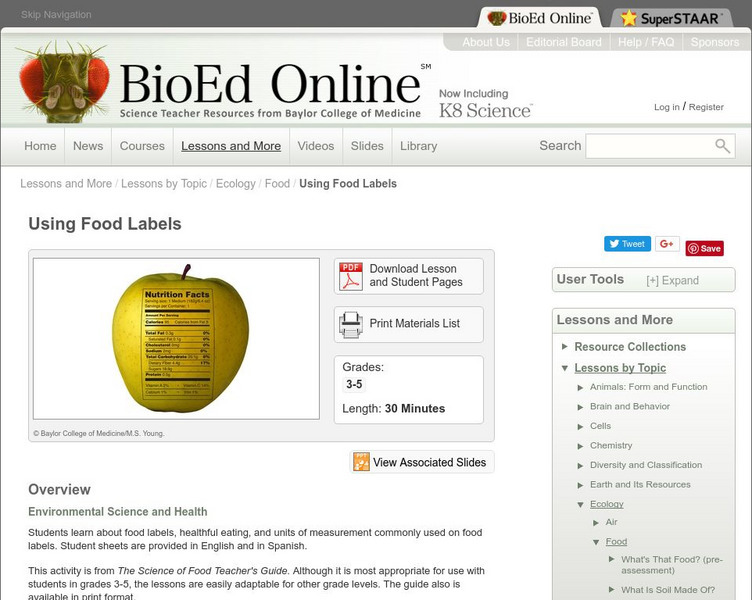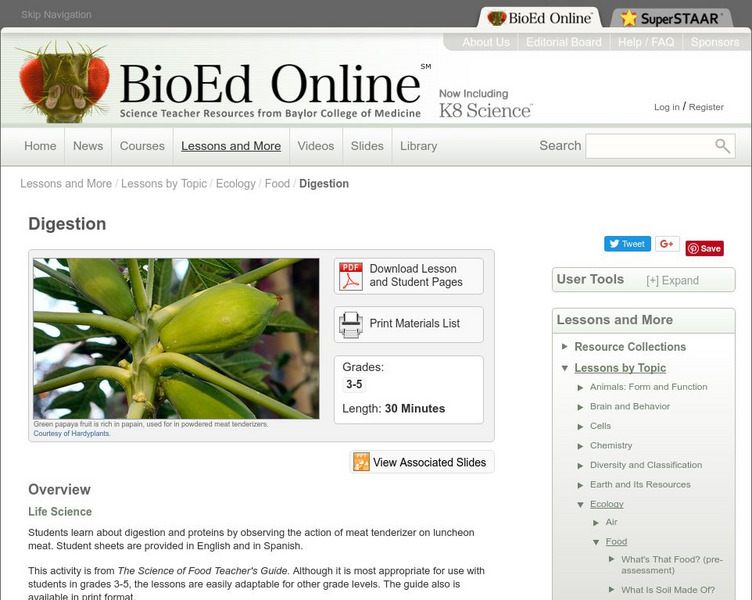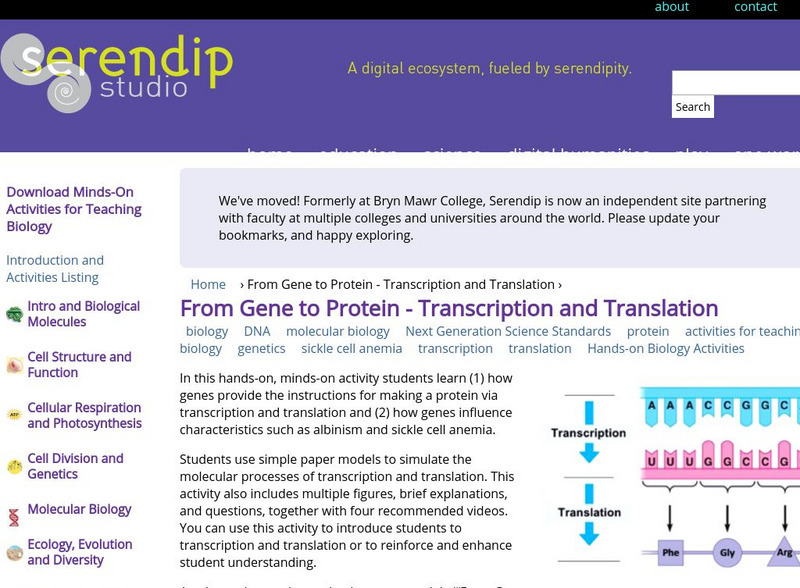TED Talks
Ted: Ted Ed: Cell vs. Virus: A Battle for Health
All living things are made of cells. In the human body, these highly efficient units are protected by layer upon layer of defense against icky invaders like the cold virus. This learning module takes a journey into the cell, introducing...
Science Buddies
Science Buddies: Computational Exploration of Protein Function
The DNA in our cells contains our "blueprints," but it's the proteins in our cells that do most of the work. The Human Genome Project has allowed us to start reading the blueprints, but we still don't understand what most of the proteins...
Yale University
Yale New Haven Teachers Institute: The Circulatory System
A detailed overview of the circulatory system, including plasma and proteins. Designed as lesson plans, this site can be helpful for students as well.
BioEd Online
Bio Ed Online: Using Food Labels
Do you know how to read a food label? Food labels provide important information about the nutritional value of foods. In this lesson students will learn about food labels, healthful eating, nutrition facts, and units of measurement...
BioEd Online
Bio Ed Online: Digestion
Digestion is the process of breaking down food into smaller units. This is done by special chemicals in the body. Proteins are important for muscles and cell growth and repair. Students learn about digestion and proteins by observing the...
University of Utah
University of Utah: Genetic Learning Center: learn.genetics: Tour of the Basics
Get it all straight! The "Tour of the Basics" will help clarify the basic principals of genetics science from DNA, genes, chromosomes, proteins, heredity, and traits.
CK-12 Foundation
Ck 12: Proteins
[Free Registration/Login may be required to access all resource tools.] Students will learn about the structures and function of proteins and how we get protein in our diet.
CK-12 Foundation
Ck 12: Central Dogma of Molecular Biology
[Free Registration/Login may be required to access all resource tools.] This module states and explains the central dogma of molecular biology which was conceived by Francis Crick.
Khan Academy
Khan Academy: Nucleus and Ribosomes
Discussion in detail of the structure and function of the nucleus and ribosomes of a cell and how they work together in the production of proteins.
CPALMS
Florida State University Cpalms: Florida Students: The Macromolecules of Life: The Proteins
A tutorial that focuses on the structure and function of proteins. Learn why proteins are one of the four primary macromolecule groups in biological systems.
CPALMS
Florida State University Cpalms: Florida Students: Macromolecules of Life: The Overview
Get a tour of the four basic biological macromolecules structure and function in this tutorial. Learn about carbohydrates, lipids, proteins, and nucleic acids.
OpenStax
Open Stax: Anatomy & Physiology: Chemical Digestion/absorption: A Closer Look
In this module, find out the locations and primary secretions involved in the chemical digestion of carbohydrates, proteins, lipids, and nucleic acids.
OpenStax
Open Stax: Anatomy & Physiology: Protein Metabolism
Students will learn how the body digests proteins, and will explain how protein can be used for energy.
OpenStax
Open Stax: Organic Compounds Essential to Human Functioning
Learn here about organic compounds, groups of carbon atoms covalently bonded to hydrogen, usually oxygen, and often other elements as well, and how they are essential to human functioning.
CK-12 Foundation
Ck 12: Life Science: Organic Compounds
[Free Registration/Login may be required to access all resource tools.] The main chemical components of living organisms are known as organic compounds and are built around the element carbon. Living things are made up of very large...
Khan Academy
Khan Academy: Connections Between Cellular Respiration and Other Pathways
Resource examines how non-glucose molecules such as carbohydrates, proteins, and lipids enter the cellular respiration pathway. Also, looks at the use of cellular respiration intermediates for biosynthesis.
Utah Education Network
Uen: Amino Acids
Lesson explores scientific principles in using eggs as a highly nutritious and versatile food source of protein.
Howard Hughes Medical Institute
Hhmi: Biointeractive: The Immunology Lab
In this lab, students perform a virtual ELISA (enzyme-linked immunosorbent assay)to test whether a particular antibody is present in a blood sample. Students engage in key science practices, including experimental design and data...
Concord Consortium
Concord Consortium: Geniventure
Geniventure engages students in exploring heredity, genetics, and the protein-to-trait relationship by breeding and studying virtual dragons. Students play through six levels of challenges, conducting simulated experiments that generate...
Concord Consortium
Concord Consortium: Geniversity for Geniverse
Geniversity has been designed to help teachers use Geniverse, free web-based software for high school biology that engages students in exploring genetics by breeding and studying virtual dragons.
Bryn Mawr College
Serendip: From Gene to Protein Transcription and Translation
Brief text summary of what young scholars learn in the Dragon Genetics II lab along with links to download Student Handouts in PDF and Word formats, and Teacher Preparation Notes in PDF format. Students use paper models to learn...
Michigan State University
Michigan State University: Peptides and Proteins
If the amine and carboxylic acid functional groups in amino acids join together to form amide bonds, a chain of amino acid units, called a peptide, is formed. A simple tetrapeptide structure is shown in the following diagram. By...
Science Buddies
Science Buddies: Project Ideas: No Whey! Milk Protein Content Changes
In this biochemistry science fair project, investigate how protein concentrations change in milk during different stages of cow lactation. The Science Buddies project ideas are set up consistently beginning with an abstract, objective,...
Science Buddies
Science Buddies: Solubility of Proteins
Some proteins are soluble in aqueous solutions and some are not. Insoluble proteins can be a problem because the proteins can form large aggregates in solution which are difficult to purify, crystallize, and use in experiments. Compare...
























